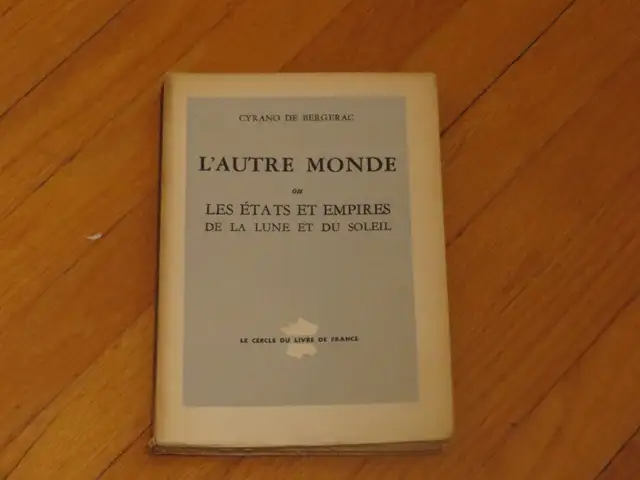
CYRANO DE BERGERAC - THE OTHER WORLD THE CIRCLE OF THE FRENCH BOOK 1960 vintage MAKE ME AN OFFER THE OTHER WORLD or THE STATES AND EMPIRES OF THE MOON, AND THE STATES AND EMPIRES OF THE SUN, by Savinien Cyrano de Bergerac The Other World or The States and Empires of the Moon, by Savinien Cyrano de Bergerac (1619–1655), written around 1650, was published after the author's death in 1657, revised by Le Bret, the friend and publisher of the freethinking writer, who wished to avoid censorship. A sequel, also censored: The States and Empires of the Sun. The States and Empires of the Moon: The World Upside Down Under the guise of a comic tale, Cyrano develops arguments capable of undermining established truths and beliefs in the name of materialist freedom. This story clearly draws from Lucian of Samosata and his True History, as well as from the Englishman Francis Godwin (The Man in the Moon, 1638), reflecting the scientific knowledge of the time. The cosmic journey, an act of imagination, is only valid if consistent with Galileo’s theories. The protagonist travels in a romantic, comic, and scientific manner through representations of the world’s order, challenging established traditions. The adventure narrative is written in the first person. The narrator travels to the Moon by attaching vials of dew to his clothes; drawn upward by the heat of the Sun, he is propelled into the sky and carried not to the Moon but to New France => he must justify his simultaneously burlesque, poetic, and scientific method of travel to those who suspect him of magic. Attempting to destroy his "machine" by exploding rockets, he is once again launched into the sky and finally lands on the Moon, a celestial body inhabited, as Francis Godwin, John Wilkins, and Pierre Borel had speculated => everything is inverted. On the Moon, Earth is called the Moon, the elderly obey the young, and virginity is a scandal. Suicide, highly recommended, is performed ceremonially: the blood of the suicide is drunk, and then people couple so that the dead may live again through the children born. Assisted by Socrates’ demon, who translates the lunar language, the narrator debates all subjects—customs, nature, beliefs—without prejudice. The States and Empires of the Sun The narrator, Drycona (an anagram of Cyrano), is pursued by the Parliament of Toulouse, which seeks to burn him at the stake for sorcery, although he merely thinks freely. He is also prosecuted for having written The States and Empires of the Moon. He continues his journey in a clearly more initiatory form. "For during this journey, one must free oneself from dogmatic traditions by exploring possible worlds, while maintaining the distance of irony, so that the quest for truth becomes a destabilization of every truth claim. Thus, a new perspective, bordering on utopia, is cast upon our world through imagination, first via the Moon, then the Sun." (Christian BIET) On the Sun, birds, trees, and fruits are capable of reason, and cabbages claim to possess souls. The birds, unrepentant atheists, fear foreigners and hate war. They observe human customs with both naivety and insight, astonished by their servitude and the oppression they endure. The birds, having not read the Bible, come to question humanity’s superiority over animals and the uniqueness of the human species within the natural order. THE CIRCLE OF THE FRENCH BOOK THE OTHER WORLD or THE STATES AND EMPIRES OF THE MOON, AND THE STATES AND EMPIRES OF THE SUN, by Savinien Cyrano de Bergerac The Other World or The States and Empires of the Moon, by Savinien Cyrano de Bergerac (1619–1655), written around 1650, was published after the author's death in 1657, revised by Le Bret, the friend and publisher of the freethinking writer, who wished to avoid censorship. A sequel, also censored: The States and Empires of the Sun. The States and Empires of the Moon: The World Upside Down Under the guise of a comic tale, Cyrano develops arguments capable of undermining established truths and beliefs in the name of materialist freedom. This story clearly draws from Lucian of Samosata and his True History, as well as from the Englishman Francis Godwin (The Man in the Moon, 1638), reflecting the scientific knowledge of the time. The cosmic journey, an act of imagination, is only valid if consistent with Galileo’s theories. The protagonist travels in a romantic, comic, and scientific manner through representations of the world’s order, challenging established traditions. The adventure narrative is written in the first person. The narrator travels to the Moon by attaching vials of dew to his clothes; drawn upward by the heat of the Sun, he is propelled into the sky and carried not to the Moon but to New France => he must justify his simultaneously burlesque, poetic, and scientific method of travel to those who suspect him of magic. Attempting to destroy his "machine" by exploding rockets, he is once again launched into the sky and finally lands on the Moon, a celestial body inhabited, as Francis Godwin, John Wilkins, and Pierre Borel had speculated => everything is inverted. On the Moon, Earth is called the Moon, the elderly obey the young, and virginity is a scandal. Suicide, highly recommended, is performed ceremonially: the blood of the suicide is drunk, and then people couple so that the dead may live again through the children born. Assisted by Socrates’ demon, who translates the lunar language, the narrator debates all subjects—customs, nature, beliefs—without prejudice. The States and Empires of the Sun The narrator, Drycona (an anagram of Cyrano), is pursued by the Parliament of Toulouse, which seeks to burn him at the stake for sorcery, although he merely thinks freely. He is also prosecuted for having written The States and Empires of the Moon. He continues his journey in a clearly more initiatory form. "For during this journey, one must free oneself from dogmatic traditions by exploring possible worlds, while maintaining the distance of irony, so that the quest for truth becomes a destabilization of every truth claim. Thus, a new perspective, bordering on utopia, is cast upon our world through imagination, first via the Moon, then the Sun." (Christian BIET) On the Sun, birds, trees, and fruits are capable of reason, and cabbages claim to possess souls. The birds, unrepentant atheists, fear foreigners and hate war. They observe human customs with both naivety and insight, astonished by their servitude and the oppression they endure. The birds, having not read the Bible, come to question humanity’s superiority over animals and the uniqueness of the human species within the natural order.
